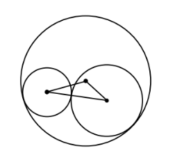Waldorf News
Reflections on our Waldorf Math Research Colloquium in NYC

By Jamie York
A couple of weeks ago, I had the privilege of attending of a Waldorf math research colloquium in New York City with 17 colleagues. We shared math puzzles, did some geometry together, and had many fruitful discussions. I was encouraged by the quality of mathematics teaching that appears to be happening in many of our Waldorf schools, and struck by how different our methods and teaching styles are.
As my professional life transitions from full-time high school math teacher to that of a traveling math missionary, I spend a good deal of time thinking about what the greatest challenges are that our Waldorf schools are facing. In respect to the teaching of math, the schools that I visit are often concerned about two things: (1) How can we ensure that, once they leave our school, our students will be adequately prepared for what faces them?; (2) With the apparent rise in the number of students with learning challenges, how can we manage to teach the full spectrum of students in our classes?

Certainly, these are fair and important questions that we all need to address at some level. But it seems to me that these two problems are intertwined and that the issues are compounded by fear – that some level of fear, perhaps subconsciously, has an influence on how we teach math.
I would guess that the majority of class teachers, and a good many of our middle school and high school math specialists, are not confident in their ability to teach math effectively. Teachers become fearful that their students will fall behind (behind what?). Parents are fearful that their children will end up as math traumatized as they are. Inevitably, the fear seeps down from the adults to the students.

I see that this fear is at least partially responsible for three symptoms of our societal math illness: an over-emphasis on procedural math, an unhealthy push to teach topics too early, and a widening of the “math gap” (the disparity between the weakest and strongest students.)
What is the solution? It’s probably not helpful for me to say: “Stop being fearful!”, but for starters we can start talking about this fear – to our parents, to our colleagues, and to ourselves. With our colleagues and our parents, we can create time for discussions about this.
We can ask, as we did together in our math teachers’ colloquium in NYC: “What math experiences would you like your students to have?” Rarely will our Waldorf parents and colleagues say that they want their kids to plow through a long list of topics as quickly as possible. Then we can ask what it really means to have our students prepared for their future math studies and the “real world”.
Whenever I have done this with a group of teachers and parents, two things quickly emerge to the top: learning to think mathematically, and being enthusiastic about learning math. Sure, our students need to have solid math skills, but the math-skills-hamster-wheel is bound to crush a student’s enthusiasm for learning and is unlikely to develop much mathematical thinking.
And how do we engender enthusiasm for learning math and develop mathematical thinking? By carving out time in our classrooms for the students to have meaningful mathematical experiences. We shared a few examples at our colloquium. One problem (from Lisa Ayrault of the Seattle Waldorf School) was to find three numbers between 1 and ½ that multiply together to equal ½. This wonderful, open-ended puzzle encourages multiple solutions and is appropriate for a variety of ages.
 Another problem (from Marisha Plotnik of the Rudolf Steiner School, NYC) was to discover a special relationship found with any circle and two inner tangent circles – specifically: how does the triangle which connects the three centers relate to the radii of the circles? A fascinating problem! (I encourage the reader to try to figure this out. Feel free to email me at JamieYorkMath@gmail.com if you need a hint or want to check your solution.)
Another problem (from Marisha Plotnik of the Rudolf Steiner School, NYC) was to discover a special relationship found with any circle and two inner tangent circles – specifically: how does the triangle which connects the three centers relate to the radii of the circles? A fascinating problem! (I encourage the reader to try to figure this out. Feel free to email me at JamieYorkMath@gmail.com if you need a hint or want to check your solution.)
Marisha told us how she spent several days of her ninth grade math class working on this problem. In our mainstream math classrooms it can seem rather irresponsible to spend so much time on one problem that isn’t on anyone’s list of necessary math topics. Yet the problem invites exploration, debate, and a depth of learning that we should all be striving for.
Naturally, this is not the easy path. It’s hard not to get sucked into the black hole of endless math skills. It’s hard not to become fearful and not to become influenced by other people’s fears. It’s hard to find the courage to step back and question why we are doing what we are doing. It’s hard to relax and find the time to do what we really should be focused on.
But if we can do it, the rewards are great.
Learn more at jamieyorkpress.com.

from etsy

 ~ Ensoul Your World With Color ~
~ Ensoul Your World With Color ~ Waldorf-inspired Homeschool Curriculum
Waldorf-inspired Homeschool Curriculum Immersive Academics and Arts
Immersive Academics and Arts Space speaks. Its language is movement.
Space speaks. Its language is movement. Caring for All Stages of Life
Caring for All Stages of Life Bringing Love to Learning for a Lifetime
Bringing Love to Learning for a Lifetime Association for a Healing Education
Association for a Healing Education Train to Teach in Seattle
Train to Teach in Seattle Flexible preparation for your new grade
Flexible preparation for your new grade Middle School Science With Roberto Trostli
Middle School Science With Roberto Trostli The Journey is Everything
The Journey is Everything Full-Time Teacher Education
Full-Time Teacher Education Transforming Voices Worldwide
Transforming Voices Worldwide Summer Programs - Culminating Class Trips
Summer Programs - Culminating Class Trips Waldorf Training in Australia
Waldorf Training in Australia Quality Education in the Heartland
Quality Education in the Heartland Great books for Waldorf Teachers & Families
Great books for Waldorf Teachers & Families Everything a Teacher Needs
Everything a Teacher Needs Apply Today: New Cohort Starts Nov. 2025
Apply Today: New Cohort Starts Nov. 2025 Jamie York Books, Resources, Workshops
Jamie York Books, Resources, Workshops Bay Area Teacher Training
Bay Area Teacher Training Roadmap to Literacy Books & Courses
Roadmap to Literacy Books & Courses RSS Feeds
RSS Feeds